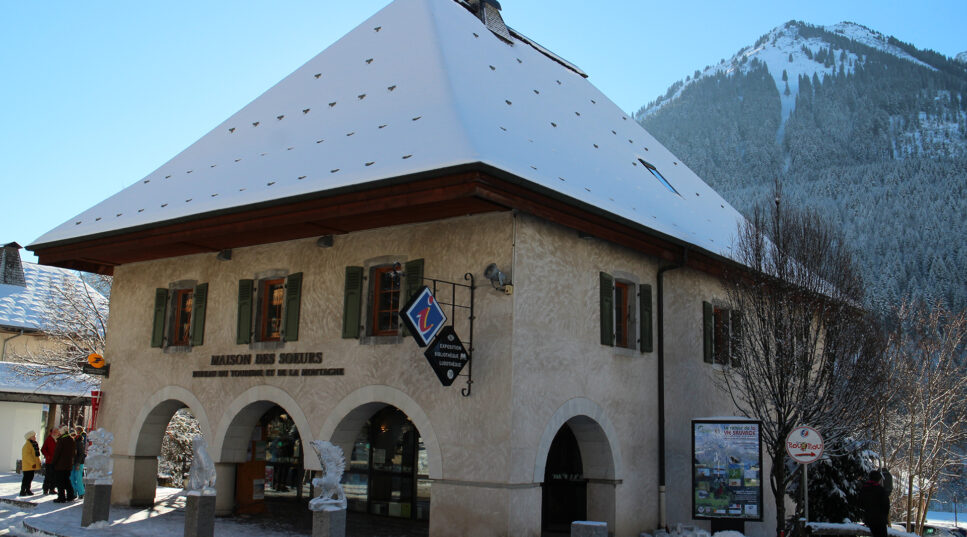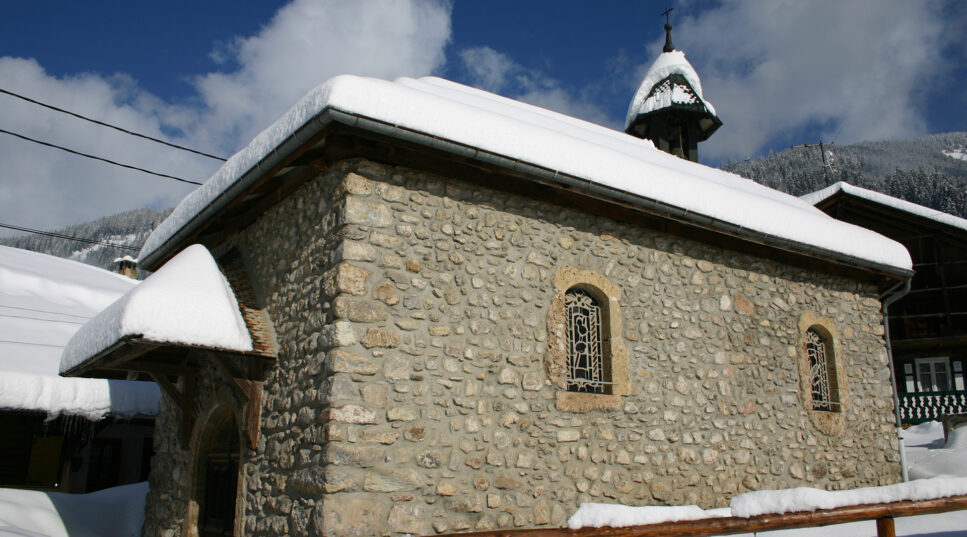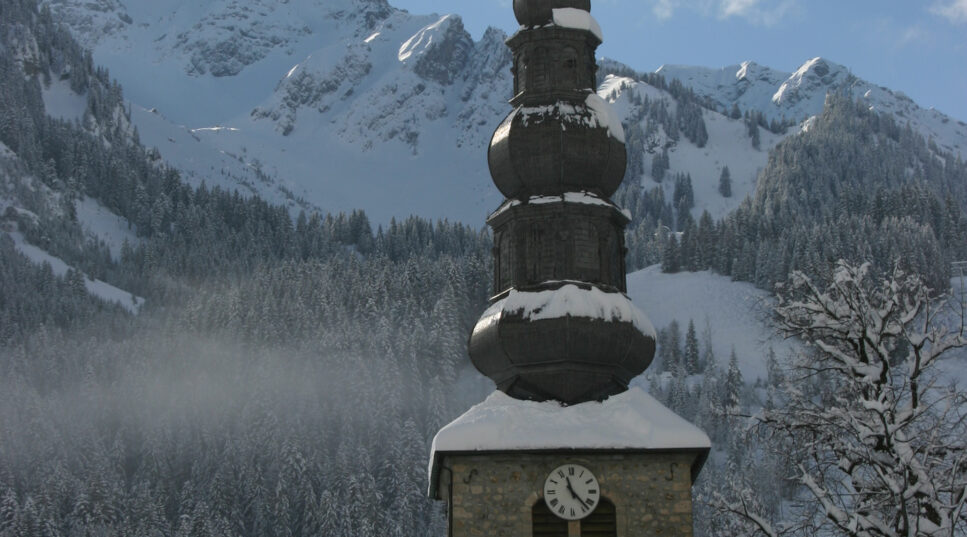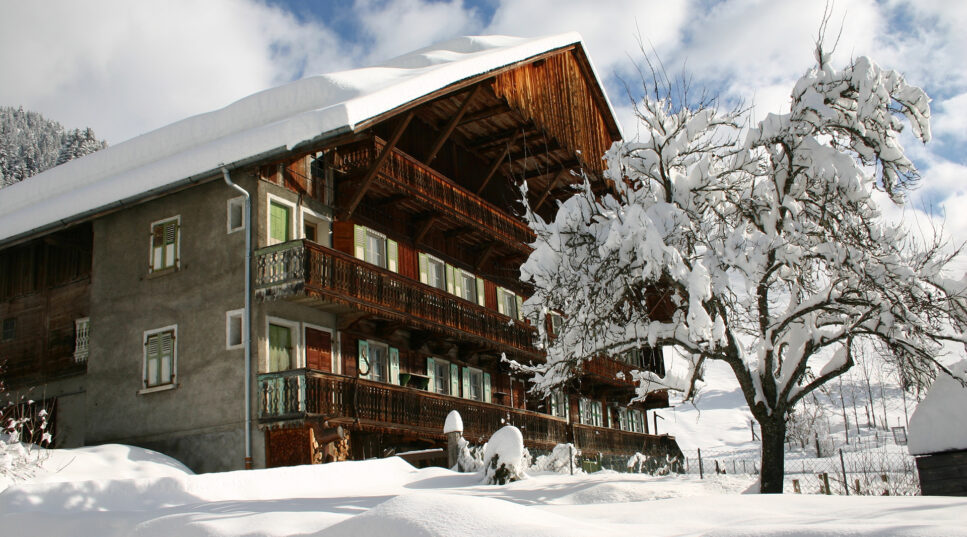All of the municipalities in the pays d’Evian vallée d’Abondance are labeled Pays d’Art et d’Histoire. This label is awarded to local authorities, which engage in the animation and enhancement of their architecture and heritage.
Historically the Abondance valley territory lies between the Portes du Soleil and Pas de Morgins glacial lock according to the valley’s donation act to the Augustinian canons in 1108. The church that oversees this large parish is in Frasses, centralised between its borders. At the beginning of the 13th century debates between Aymon de Grandson, the Bishop of Geneva, and Abondance Abbey took place to choose the priest for Frasses church. The Abbey decided in favour of Pope Innocent IV (1243-1254). The St Maurice des Frasses church is downgraded to a secondary church and becomes La Chapelle des Frasses. The monastery’s church, Saint Marie, is accorded parish primary status. In the centuries that follow, the parish’s name is sometimes linked to the valley to become La Chapelle de l’Abondance. A first parish split took place when the church is reconstructed at its present location in Contamines at the beginning of the 15th century. But independence from Abbey will happen after François de Sales († 1622) arrives in the 17th century. During the revolution, the village took the name of Mont d´Or in 1792 but resumed its name La Chapelle a few years later in 1815. La Chapelle-en-Chablais also appears during the 19th century. The 27th February 1961 decree, published in the Journal Officiel on 4th March 1961, makes the municipality’s new name official: La Chapelle d’Abondance.
During the winter season 1959-1960, the town opened its first chairlift Clos Baron, which was also used as a lift to lower the milk churns down from the pastureland during the summer.

La Maison des Sœurs was originally a building constructed for the Sisters of Charity Order nuns in 1842.
The Sisters of Charity, an order founded by Jeanne Antide Thouret in the Doubs, were summoned by the La Chapelle parish to come and teach young girls.
Built in 1842, the ground floor housed a pharmacy-herbalist, classrooms and a laundry room.
The sisters’ accommodation was on the 1st floor.
Long abandoned, it was restored to become the current Tourist Office reception, a games library and an exhibition space. Situated in La Chapelle d’Abondance’s village centre, the Maison des Sœurs is instantly recognisable with its arcades facing the Notre-Dame de Compassion chapel.

The two village chapels founded in the 17th century recall the visit from François de Sales, Bishop and Prince of Geneva, who stimulated the religious ardor of the inhabitants during his pastoral visits to La Chapelle, following the danger of Genovese Calvinism. Discreet decorations and especially the statues, bear witness to a time where the cultural relationship with the saints and Notre Dame was hugely important.
Notre Dame de Compassion
It is in the village centre. According to the legend this chapel would have been built on the site of another place of worship destroyed when the banks of the River Chevenne overflowed. Its original name: Notre Dame de Pitié, de St Félix, de St André and all the Saints, hadn’t been chosen by chance!
The Saint Jacques Chapel
In the La Ville du Nant hamlet there is a statue of a pope, St Félix may be in memory of Félix V, anti-pope in Basel, better known under the name of Amédée VIII, Duke of Savoy who, as he was removed from this cumbersome tiara, came to piously end his days at the Ripaille Manor House on the shores of Lake Geneva.

Its construction began in the 14th century and ended in the 18th century.
Francis Wey, a 19th century writer who was commissioned by Haute-Savoie to describe to France this recently attached new area, is surprised by the bell tower’s appearance: “We thus reach La Chapelle whose fantastic bell tower ends with two superimposed lanterns, separated by copper balls… “

The Abondance Valley is fortunate to have their own traditional architecture: beautiful wooden farms that you will find nowhere else. The visitor is first struck by the vast proportions of these constructions. Then your gaze is drawn to the 2 or 3 beautifully carved and decorated galleries that run along the facade. These huge farms can include 2 symmetrical dwellings. The cellars are built into the stone foundations.
The living space is at the front (at the level of the first balcony), separated from the stables by a long corridor.
The hayloft floor on the upper balcony is used for drying crops. At the rear of the farm, there’s a slope providing direct access to the hayloft.
The soapstone stove is the typical heating method found in large dwellings located in the upper part of the valley. The stones will have been cut in the Saix quarry and often, the stove will have been brought from the Bagnes valley in Valais, hence its evocative name, Bagnard.
Francis Wey, a travel journalist from 1865, when entering the Passengués hamlet in La Chapelle is impressed by “the largest and most original farms that one can imagine. They are sometimes topped with tall pyramidal chimneys made from planks, at the centre of which they make vacherins, renowned cheese from the Abondance area. Habitat and architecture are not an accident. They correspond to particular and original solutions to the problems presented by the natural environment, two essential requirements must be met: having a space large enough to shelter animals and people, and the food reserves necessary for both. In this “civilisation” hay and storage volume will depend on the number of animals wintered in the stables”.
Many cultural visits are organised throughout the year, especially in winter and summer! Find all the information in the village agenda!